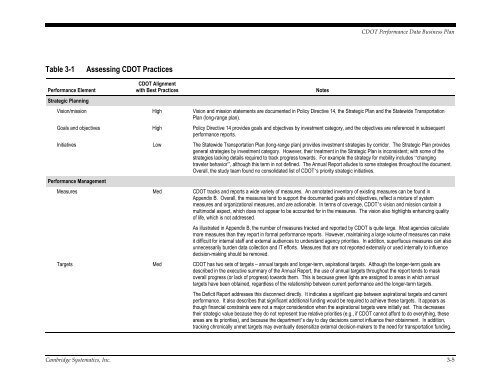CDOT Performance Data Business Plan - Cambridge Systematics
CDOT Performance Data Business Plan - Cambridge Systematics
CDOT Performance Data Business Plan - Cambridge Systematics
You also want an ePaper? Increase the reach of your titles
YUMPU automatically turns print PDFs into web optimized ePapers that Google loves.
<strong>CDOT</strong> <strong>Performance</strong> <strong>Data</strong> <strong>Business</strong> <strong>Plan</strong><br />
Table 3-1<br />
Assessing <strong>CDOT</strong> Practices<br />
<strong>Performance</strong> Element<br />
Strategic <strong>Plan</strong>ning<br />
<strong>CDOT</strong> Alignment<br />
with Best Practices<br />
Vision/mission High Vision and mission statements are documented in Policy Directive 14, the Strategic <strong>Plan</strong> and the Statewide Transportation<br />
<strong>Plan</strong> (long-range plan).<br />
Goals and objectives High Policy Directive 14 provides goals and objectives by investment category, and the objectives are referenced in subsequent<br />
performance reports.<br />
Initiatives Low The Statewide Transportation <strong>Plan</strong> (long-range plan) provides investment strategies by corridor. The Strategic <strong>Plan</strong> provides<br />
general strategies by investment category. However, their treatment in the Strategic <strong>Plan</strong> is inconsistent; with some of the<br />
strategies lacking details required to track progress towards. For example the strategy for mobility includes “changing<br />
traveler behavior”, although this term in not defined. The Annual Report alludes to some strategies throughout the document.<br />
Overall, the study team found no consolidated list of <strong>CDOT</strong>’s priority strategic initiatives.<br />
<strong>Performance</strong> Management<br />
Measures Med <strong>CDOT</strong> tracks and reports a wide variety of measures. An annotated inventory of existing measures can be found in<br />
Appendix B. Overall, the measures tend to support the documented goals and objectives, reflect a mixture of system<br />
measures and organizational measures, and are actionable. In terms of coverage, <strong>CDOT</strong>’s vision and mission contain a<br />
multimodal aspect, which does not appear to be accounted for in the measures. The vision also highlights enhancing quality<br />
of life, which is not addressed.<br />
As illustrated in Appendix B, the number of measures tracked and reported by <strong>CDOT</strong> is quite large. Most agencies calculate<br />
more measures than they report in formal performance reports. However, maintaining a large volume of measures can make<br />
it difficult for internal staff and external audiences to understand agency priorities. In addition, superfluous measures can also<br />
unnecessarily burden data collection and IT efforts. Measures that are not reported externally or used internally to influence<br />
decision-making should be removed.<br />
Targets Med <strong>CDOT</strong> has two sets of targets – annual targets and longer-term, aspirational targets. Although the longer-term goals are<br />
described in the executive summary of the Annual Report, the use of annual targets throughout the report tends to mask<br />
overall progress (or lack of progress) towards them. This is because green lights are assigned to areas in which annual<br />
targets have been obtained, regardless of the relationship between current performance and the longer-term targets.<br />
Notes<br />
The Deficit Report addresses this disconnect directly. It indicates a significant gap between aspirational targets and current<br />
performance. It also describes that significant additional funding would be required to achieve these targets. It appears as<br />
though financial constraints were not a major consideration when the aspirational targets were initially set. This decreases<br />
their strategic value because they do not represent true relative priorities (e.g., if <strong>CDOT</strong> cannot afford to do everything, these<br />
areas are its priorities), and because the department’s day to day decisions cannot influence their obtainment. In addition,<br />
tracking chronically unmet targets may eventually desensitize external decision-makers to the need for transportation funding.<br />
<strong>Cambridge</strong> <strong>Systematics</strong>, Inc. 3-5

















